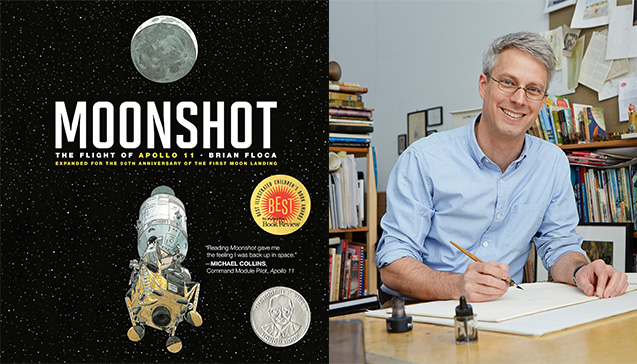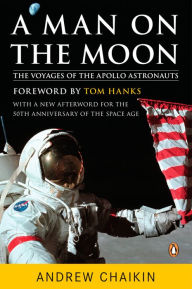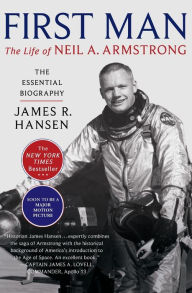Interview: Moonshot Author Brian Floca on the Smell of Moon Dust, and Seeing the Earth from Space

Debug Notice: No product response from API
Moonshot: The Flight of Apollo 11, by Brian Floca is the perfect picture book to introduce a whole new generation of young readers to the wonders of space travel. Newly expanded and timed to coincide with the 50th anniversary of the first moon landing, this beautifully illustrated book is packed with space facts and will leave your young reader marveling at the night sky. We spoke with Floca about how he researched this historic event, the smell of moon dust, and seeing the earth from space.
Congrats on your amazing, awe-inspiring new picture book! I know that so many young readers and space enthusiasts are going to love it.What was your inspiration behind writing the story about the Flight of Apollo 11? Did you have dreams of being an astronaut as a kid?
Thank you! You know, I can’t say I ever seriously imagined I’d end up with astronaut on my resumé, but I do remember being interested in the story of the Apollo moon landings from a very early age.The imagery, especially, made an impression: the gigantic Saturn V rocket lifting off, the astronauts on the moon, the earth as seen from space. And then at a certain point I picked up Andrew Chaikin’s great book A Man on the Moon, and that book was the beginning for me in terms of not just thinking, “wow, that’s an amazing picture,” but also in beginning to understand and think about why and how the missions were flown, and what they meant. That book led to others, and the more I learned the more I wanted to try my own take on the story.
Moonshot: The Flight of Apollo 11, by Brian Floca is the perfect picture book to introduce a whole new generation of young readers to the wonders of space travel. Newly expanded and timed to coincide with the 50th anniversary of the first moon landing, this beautifully illustrated book is packed with space facts and will leave your young reader marveling at the night sky. We spoke with Floca about how he researched this historic event, the smell of moon dust, and seeing the earth from space.
Congrats on your amazing, awe-inspiring new picture book! I know that so many young readers and space enthusiasts are going to love it.What was your inspiration behind writing the story about the Flight of Apollo 11? Did you have dreams of being an astronaut as a kid?
Thank you! You know, I can’t say I ever seriously imagined I’d end up with astronaut on my resumé, but I do remember being interested in the story of the Apollo moon landings from a very early age.The imagery, especially, made an impression: the gigantic Saturn V rocket lifting off, the astronauts on the moon, the earth as seen from space. And then at a certain point I picked up Andrew Chaikin’s great book A Man on the Moon, and that book was the beginning for me in terms of not just thinking, “wow, that’s an amazing picture,” but also in beginning to understand and think about why and how the missions were flown, and what they meant. That book led to others, and the more I learned the more I wanted to try my own take on the story.
A Man on the Moon: The Voyages of the Apollo Astronauts
A Man on the Moon: The Voyages of the Apollo Astronauts
By
Andrew Chaikin
Foreword by
Tom Hanks
In Stock Online
Paperback $22.00
I learned so much about space travel from reading this book! It is so thoroughly researched—can you tell us a bit about the research process?
After the Chaikin book, I went on to astronaut Michael Collins’ classic Carrying the Fire, and James Hansen’s First Man, and others. I watched Al Reinert’s beautiful documentary For All Mankind, and visited the Air and Space Museum in Washington and the Johnson Space Center in Houston. It has to be said the internet was incredibly helpful, too. There’s a bottomless supply of NASA material online—photographs, videos, diagrams, press releases, flight plans, on and on. I also had extremely helpful conversations with people who’ve been studying this material for a long time, and I’m indebted to them. As all this may imply, the story of the moon landings can be complicated, and indeed daunting at first, but the story rewards investigation. There’s an engineer’s logic to how everything was done, and each thing you figure out has a way of leading you to the next thing to figure out, and there’s a pleasure to be found in following the thread.
I learned so much about space travel from reading this book! It is so thoroughly researched—can you tell us a bit about the research process?
After the Chaikin book, I went on to astronaut Michael Collins’ classic Carrying the Fire, and James Hansen’s First Man, and others. I watched Al Reinert’s beautiful documentary For All Mankind, and visited the Air and Space Museum in Washington and the Johnson Space Center in Houston. It has to be said the internet was incredibly helpful, too. There’s a bottomless supply of NASA material online—photographs, videos, diagrams, press releases, flight plans, on and on. I also had extremely helpful conversations with people who’ve been studying this material for a long time, and I’m indebted to them. As all this may imply, the story of the moon landings can be complicated, and indeed daunting at first, but the story rewards investigation. There’s an engineer’s logic to how everything was done, and each thing you figure out has a way of leading you to the next thing to figure out, and there’s a pleasure to be found in following the thread.
What was the most surprising or interesting fact about Apollo 11 and the moon landing that you discovered through writing the book? (I loved learning some of the little details, like about how the astronauts made soup!)
I love the soup, too! Maybe my favorite detail—one little thing that jumped out at me the first time I read it—is that after Armstrong and Aldrin finished their moon walk and climbed back into the lunar module and removed their helmets, they could smell the dust they’d carried in on their spacesuits. It reminded them of wet ashes, or spent gunpowder. Smell is such an evocative sense, and the idea that they were able in essence to smell the moon I found remarkable.
Carrying the Fire : An Astronaut's Journeys
Paperback $17.00
Carrying the Fire : An Astronaut's Journeys
By Charles A. Lindbergh , Michael Collins
In Stock Online
Paperback $17.00
The book is beautifully written and illustrated. I particularly loved the illustration of the astronauts looking back at the Earth from the moon. Do you have a favorite illustration or moment from this book?
I’m glad you like that particular picture. One of the things that interests me most about making picture books is actually trying to make all the pictures in the book work together—thinking not just about what any one picture will look like to the reader, but also about what it will feel like for the reader to travel from picture to picture. I think the moment in the book with which I’m happiest is that one in which you the astronaut looking up into the moon’s sky, you turn the page, and then you see that picture you mentioned of the earth. Those two pictures and the page turn between them, too, work as a kind of unit in my mind, if that makes sense.
The book is beautifully written and illustrated. I particularly loved the illustration of the astronauts looking back at the Earth from the moon. Do you have a favorite illustration or moment from this book?
I’m glad you like that particular picture. One of the things that interests me most about making picture books is actually trying to make all the pictures in the book work together—thinking not just about what any one picture will look like to the reader, but also about what it will feel like for the reader to travel from picture to picture. I think the moment in the book with which I’m happiest is that one in which you the astronaut looking up into the moon’s sky, you turn the page, and then you see that picture you mentioned of the earth. Those two pictures and the page turn between them, too, work as a kind of unit in my mind, if that makes sense.
First Man: The Life of Neil A. Armstrong
First Man: The Life of Neil A. Armstrong
Paperback $18.00
Can you tell us what it was like to write and illustrate this incredible true story? Did the pictures or the words come first, or was it somewhere in the middle? Was it a different process than your other books?
From the beginning there were moments in the the mission that spoke to me pretty clearly, including that idea of seeing the earth from the moon, and the liftoff, and the splashdown. I sketched those out roughly, with rough text, and then it was a matter of figuring out how to connect those moments, and give the whole thing the right introduction and conclusion, and then also how to incorporate additional material as I was learning about it and when it felt necessary or interesting, and how to refine what I’d already written—and also a matter of figuring out what I should leave out of the book so that it would feel like a narrative and not an encyclopedia entry. If that process sounds like a juggling act, it is!
Can you tell us what it was like to write and illustrate this incredible true story? Did the pictures or the words come first, or was it somewhere in the middle? Was it a different process than your other books?
From the beginning there were moments in the the mission that spoke to me pretty clearly, including that idea of seeing the earth from the moon, and the liftoff, and the splashdown. I sketched those out roughly, with rough text, and then it was a matter of figuring out how to connect those moments, and give the whole thing the right introduction and conclusion, and then also how to incorporate additional material as I was learning about it and when it felt necessary or interesting, and how to refine what I’d already written—and also a matter of figuring out what I should leave out of the book so that it would feel like a narrative and not an encyclopedia entry. If that process sounds like a juggling act, it is!
What’s up next for you?
I’m not as far along in the current project as I’d like to be—that statement is true most of the time, unfortunately—so I won’t say too much but it’s another very American story, and also to do with history and technology. It’s a quieter and less familiar subject than Apollo 11, but there are beautiful moments in it, and it’s a story I’m excited about trying to introduce to young readers.
Where can our readers find you?
I’m online at brianfloca.com. Thank you!
Moonshot: The Flight of Apollo 11 is on B&N bookshelves now.

